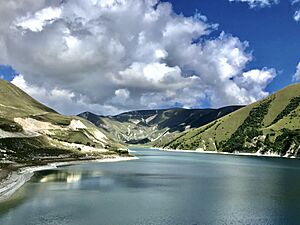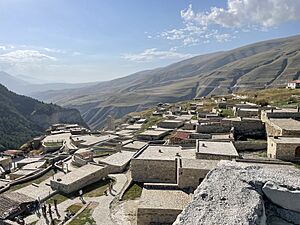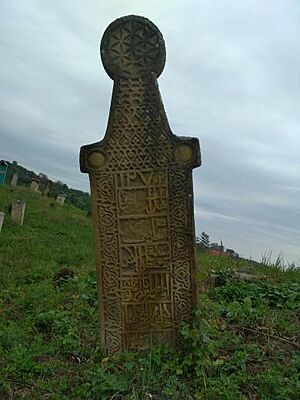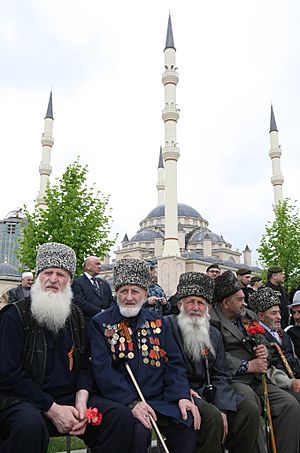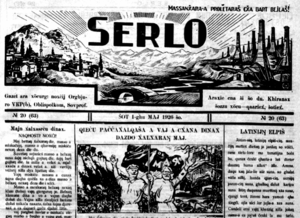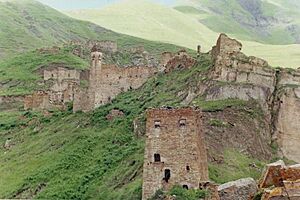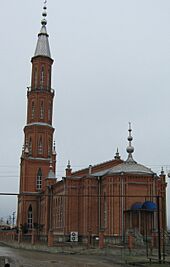Chechens facts for kids
| Нохчий Noxçiy |
|
|---|---|
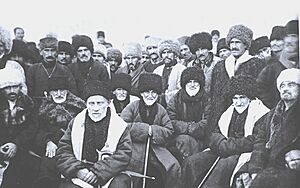 |
|
| Total population | |
| c. 2 million | |
| Regions with significant populations | |
| Russia | 1,674,854 |
| Chechnya | 1,456,792 |
| Dagestan | 99,320 |
| Rostov Oblast | 14,316 |
| Stavropol Krai | 13,779 |
| Ingushetia | 12,240 |
| Moscow Oblast | 11,491 |
| Volgograd Oblast | 8,038 |
| Khanty-Mansi Autonomous Okrug | 7,085 |
| Astrakhan Oblast | 6,873 |
| Saratov Oblast | 5,748 |
| European Union France Austria Belgium Germany Sweden Denmark Poland |
130,000 (2009) |
| Turkey | 100,000 |
| Kazakhstan | 33,557 |
| Jordan | 12,000–30,000 |
| Iraq | 11,000 |
| Georgia | 10,100 (including Kist people) |
| Syria | 6,000–35,000 |
| Azerbaijan | 5,300 |
| Egypt | 5,000 |
| Ukraine | 2,877 |
| United Arab Emirates | 2,000–3,000 |
| Kyrgyzstan | 1,709 |
| Finland | 891 |
| United States | 250–1,000 |
| Latvia | 136–189 |
| Languages | |
| Chechen | |
| Religion | |
| Sunni Islam | |
| Related ethnic groups | |
| Other Nakh peoples (Ingush, Bats, Kists) | |
The Chechens are a group of people who originally come from the North Caucasus region. They are the largest group of people in this area. Most Chechens call themselves Nokhchiy. They are mostly Muslims and live in Chechnya, which is a republic within Russia.
The North Caucasus has been invaded many times throughout history. This has made the Chechen people very strong and proud of their community. Chechen society is mostly equal, organized into family groups called teips. These groups are informally connected into larger unions called tukkhums.
Contents
Understanding the Name: Chechen Origins
Where Does the Name "Chechen" Come From?
The name Chechen (or Chechency in Russian) likely comes from a central area in Chechnya. This area had important villages named after the word Chechen. These places included Chechan and Nana-Checha ("Mother Checha"). The name Chechen appeared in Russian writings in the late 1500s. It means "inside territory" in the Nakh languages. The villages named Chechan were always in the "Chechen flatlands."
What Does "Nokhchiy" Mean?
Chechens call themselves Nakhchiy or Nokhchiy. The oldest mention of Nakhchiy was in 1310 by a Georgian leader. Some historians think the name is linked to the city Nakhchivan. The word Nakhchiy can also mean "people of the territory."
Where Chechens Live: Homeland and Beyond
Most Chechens live in their homeland, Chechnya. Many also live in other parts of Russia, like Dagestan and Moscow.
Outside of Russia, many Chechens live in Kazakhstan, Turkey, Jordan, and Iraq. Some of these families left Chechnya during the Caucasian War in the 1800s. Others were forced to move to Kazakhstan in 1944 by Joseph Stalin. After the recent Chechen Wars, many Chechen refugees moved to countries in Europe.
A Look Back: Chechen History
Ancient Roots: The First Chechens
The Chechens are part of the Nakh peoples. They have lived in the mountains of the North Caucasus for a very long time. Archeologists have found signs of their presence dating back to 3000 B.C. Some experts believe their ancestors might have come from the Fertile Crescent around 10,000 to 8,000 B.C.
The Chechens, Ingush, and Bats are the only surviving Nakh peoples. Some scholars think they are descendants of the Hurrians and Urartians, who built great civilizations in the Near East.
Early Kingdoms: The Durdzuks
The ancestors of today's Chechens and Ingush were known as the Durdzuks. Ancient Georgian writings say that Durdzuk, a descendant of Kavkasos, established a strong state around 400-300 B.C. The Durdzuks were powerful and even defeated the Scythians in the first millennium B.C.
Facing Invaders: Medieval Times
During the Middle Ages, the lowlands of Chechnya were controlled by groups like the Khazars and Alans. Over time, Islam slowly spread among the Chechens, though their old pagan beliefs were still strong.
Chechnya was greatly damaged by the Mongol invasions in the 1200s and by Tamerlane in the 1300s. Chechen folktales often tell stories of these battles. One story talks about an old hunter named Idig who, with his friends, defended the Dakuoh mountain for 12 years against the Mongol-Tatars.
The battle lasted twelve years. The main wealth of the Chechens – livestock – was stolen by the enemies. Tired of the long years of hard struggle, the Chechens, believing the assurances of mercy by the enemy, descended from the mountain, but the Mongol-Tatars treacherously killed the majority, and the rest were taken into slavery. This fate was escaped only by Idig and a few of his companions who did not trust the nomads and remained on the mountain. They managed to escape and leave Mount Dakuoh after 12 years of siege.
The Chechens are known for being one of the few peoples who successfully fought off the Mongols twice. This struggle helped shape their strong national identity and their clan-based society.
Modern History: Russian Expansion and Wars
From the 1500s, Russia began to expand south, leading to more clashes with the Chechens. The Chechens were organized into independent clans led by a National Council.
In the late 1700s and 1800s, Russia began a full conquest of the North Caucasus in the Caucasian War. General Yermolov, a Russian commander, was very harsh towards the Chechens. He even founded the city of Grozny, which is now the capital of Chechnya. Chechen resistance was strongest under the leader Imam Shamil. The Chechens were finally defeated in 1861 after a long and bloody war. Many Chechens died, and large numbers were forced to move to the Ottoman Empire.
Challenges in the 20th Century
Throughout the 1900s, Chechens continued to resist Russian and Soviet rule. In 1944, during World War II, the Soviet leader Joseph Stalin ordered all Chechens to be deported to Central Asia. Many Chechens died during this forced move, and their culture was greatly harmed. They were allowed to return in 1957, but they faced discrimination.
After the Soviet Union broke apart in the 1990s, Chechens tried to gain independence. This led to two wars with the new Russian state, starting in 1994.
Chechen Language: A Unique Voice
The main language of the Chechen people is Chechen. It belongs to the family of Nakh languages. The Chechen language is related to Ingush, spoken in the neighboring region of Ingushetia, and Batsbi, spoken in parts of Georgia.
Over time, Chechens have used different alphabets, including Georgian, Arabic, and Latin. Today, the official writing system is the Russian Cyrillic alphabet. Most Chechens living in their homeland can understand Ingush easily. Many Chechens living outside of Russia also speak the language of the country they live in, such as English, French, or Turkish.
Chechen Culture: Traditions and Values
Before they adopted Islam, Chechens had their own unique beliefs and traditions. They had many rituals, especially related to farming, like rain ceremonies. Chechens remember their history through illesh, which are epic poems and stories.
Chechen society is based on equality and respect for each person. It is structured around tukkhums (unions of clans) and about 130 teips, or clans. These clans are connected by land and family lines. The Chechen way of life is called nokhchallah, which means "Chechen character." This code includes honor, good behavior, generosity, and protecting the honor of women. An old Chechen saying is that members of Chechen society are "free and equal like wolves."
Chechens have a strong sense of community. This is supported by their old clan system and nokhchalla. They believe they are descended from a hero named Turpalo-Nokhchuo ("Chechen Hero"). The wolf is a national symbol. Chechens also have a deep love for nature, their farms, and forests.
Freedom is a very important value in Chechen culture. Many national heroes fought for independence. A common greeting in Chechen, marsha oylla, means "enter in freedom." The word for freedom also includes ideas of peace and success.
Chechen Religion: Sunni Islam
Most Chechens are Sunni Muslims. They follow either the Shafi'i or the Hanafi schools of Islamic law. The Shafi'i school is very traditional among Chechens. Many Chechens also follow the mystical Sufi tradition, belonging to Sufi brotherhoods called tariqah. The two main Sufi groups in the North Caucasus are the Naqshbandiyya and the Qadiriyya. There are also small groups of Christians and atheists among Chechens.
It's not true that all Chechens are strict fundamentalist Muslims. However, in recent years, some new trends have appeared. Some armed groups have adopted a more radical form of Islam. At the same time, the government in Chechnya has been promoting its own version of "traditional Islam," including some elements of Sharia law.
See also
- List of Chechen people
- Teip (Nakh clans)
- Nakh peoples
- North Caucasian peoples
- Islam in Russia
- Chechens in Jordan
- Chechens in Syria
- Chechens in Turkey
- Chechens in Iraq
- Chechens in France


